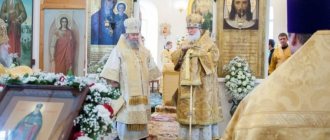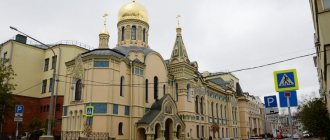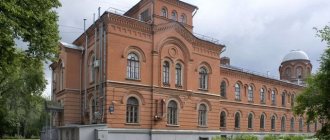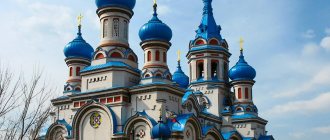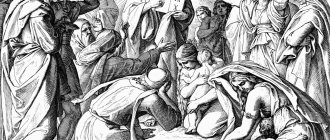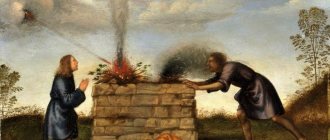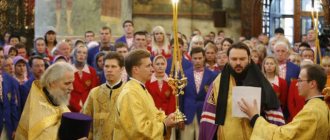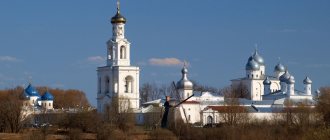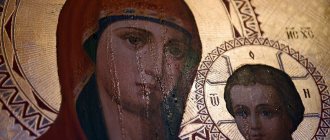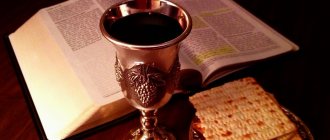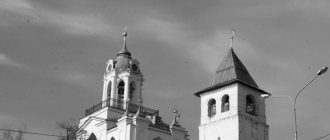Meaning of the word temple
- the central and only place of worship of the Israeli people to their God, the house of the name of the Lord (1 Kings 5:5), built according to the will and drawings of David by his son Solomon in Jerusalem on Mount Moriah (2 Chronicles 3:1), then renewed by Zerubbabel and rebuilt by Herod ( cm.
below).
The temple replaced the tabernacle ( see
) when the people of Israel, after forty years of walking through the deserts, settled in the land of Canaan.
In Scripture, the tabernacle, which appeared as its prototype, is also called a temple (1 Sam. 1:9; 1 Sam. 3:3; Ps. 5:8; Ps. 27:4; Ps. 137:2), as well as the works and bodies of individual believers themselves. (1 Cor. 3:16 -17; 1 Cor. 6:19) and the Lord God Himself and His Lamb (Rev. 21:22; in the same sense, other references to the temple in the book of Revelation must be understood).
In relation to the Jerusalem Temple, this word refers to both only one middle part of the building (1 Kings 6:5,17,22; 2 Chronicles 3:13) and the entire building (1 Kings 6:10, etc.), as well as the entire complex of buildings along with all the courtyards and porticos. For when it is said that the Lord taught in the temple (Luke 19:45,47), then only courtyards are meant ( possibly
, only external), for, not being from the tribe of Levi and a priest, the Savior definitely did not enter the inner court and the temple building itself (also
see
Luke 2:27,37; Luke 18:10; Acts 3:1 ; Acts 5:20,25; Acts 21:26 -30; Acts 22:17; Acts 24:18; Acts 26:21).
In this regard, it should be noted that all images of the temple, similar to Orthodox churches or Catholic cathedrals, in which worshipers stand, are completely incorrect, because no one except the priests had the right to enter inside the building (very small and dark in size - see
below) . Everyone was praying in one of the outer courtyards.
The temple in many places is also called the house of God and the house of the Lord.
1. Temple of Solomon.
The first temple built in Jerusalem was very beautiful and rich. There was no other such beautiful structure on earth. It was compared to other places of worship of various deities as the sun is compared to small stars. Looking at the second temple during its construction, the old people who saw the first temple cried (Ezra 3:12).
It was spent on the temple (according to 1 Chronicles 22:14; 1 Chronicles 29:4,7): 3888.03 tons
gold, 36,612
tons
of silver, much more than 648
tons
of copper and more than 3,600
tons
of iron (
see
1 Kings 7:47; 1 Chronicles 22:14; iron).
The price of these materials alone (not counting precious stones - see
1 Chronicles 29:1,8, and other materials) is unheard of, both according to ancient and modern estimates.
For comparison, we can recall that the pay of a soldier and a day laborer is 1.00 .
equaled approximately 1
kg
of silver per year (
see
money).
( see also
Solomon)
The structural details of the first temple (central building) are described in 1 Kings.
6;
1 Kings 7:15 -51; 2 Chronicles 3:1 -5.1. It was 35 m
m
wide and consisted of three parts: a vestibule - 5
m
, a middle part - 20
m
, and a far part (the Holy of Holies, davir) - 10
m
.
The height of the middle part was 15 m
.
Apparently, the porch was of the same height (according to 2 Chronicles 3:4 - 60 m
).
The height of the two copper columns that supported the upper part of the vestibule was 9 m
(1 Kings 7:15; 2 Kings 25:17; Jer. 52:21) or 17.5
m
(2 Chronicles 3:15, but
perhaps
the length of two columns is indicated here). If the last figure is more accurate than the previous one, then the vestibule was higher than the middle part of the temple building and its general appearance was stepped. The diameter of the columns was two meters.
The temple was surrounded on three sides by an extension of three floors with a total height of 7.5 m
. To the left of the entrance to the temple (on the south side) a round staircase led to the second floor of this extension.
The stone walls of the temple inside and outside were lined with planks (1 Kings 6:9,15).
At the top of the middle part, blind (decorative) windows were made (1 Kings 6:4).
The inside of the temple was illuminated only by its own lamps. Only the rays of the rising sun could penetrate through the front door. Behind the curtain, as in the tabernacle, David was always dark.
A permanent altar of incense was installed in front of the Holy of Holies (the farthest compartment) (1 Kings 6:22). All surfaces of the walls, ceiling and floor of the temple were completely lined with gold. The porch (and its upper part - the “upper rooms”) was also lined with gold (2 Chron. 3:4,9). The thickness of this coating in davir was 0.2 mm (2.9 g
gold per cm2) (2 Chron. 3:8). The temple was decorated inside and out with carvings (1 Kings 6:29) and precious stones (2 Chronicles 3:6).
Directly adjacent to the temple was the “priestly court,” and around it there was a “great court” (2 Chron. 4:9), which was surrounded by a wall. The inner courtyard, apparently, was not surrounded by a wall, but was higher than the outer one (1 Kings 6:36; Jer. 36:10).
The following gates are mentioned in the Bible ( see:
) in the fence of the temple or in the city walls associated with it, the position of which in most cases is now impossible to determine:
upper ( poss.
, facing the north) (2 Kings 15:35; 2 Chronicles 23:20; 2 Chronicles 27:3; Jer. 20:2; Ezek. 9:2) (in 2 Kings 11:6 they are called Shur, and in 2 Chronicles. 23:5 - Yesod),
internal (Ezek.8:3,14) ( possibly
, previous),
eastern (Neh.3:29; Ezek.8:16; Ezek.10:19; Ezek.11:1; Ezek.43:1; Ezek.46:1) (in 1 Chr.9:18 the royal ones are named, and in Jer.17:19 - the sons of the people),
Hammifkad (Neh.3:31),
altar (Ezek.8:5),
new (Jer.26:10; Jer.36:10) ( ·possibly
, upper),
northern (Jer.8:14) ( poss.
, upper),
third entrance (Jer.38:14),
Shallechet (1 Chronicles 26:16).
m high was installed in front of the entrance to the temple.
and 10 x 10
m
in plan (2 Chron. 4:1).
The temple took 7.5 years to build (1 Kings 6:1.38) and was consecrated around 962 .
·before-RH
.
This magnificent temple, already under the son of Solomon, was plundered by the Egyptian king Shusakim (1 Kings 14:26), and King Asa himself gave the rest of its treasures to the Syrians (1 Kings 15:18). Later the temple was restored, but the Israeli king Joash again almost completely plundered it (2 Kings 14:14). Then it was cleansed by the Jewish king Ahaz (2 Kings 16:8), followed by Hezekiah (2 Kings 18:15 -16). Manasseh finally desecrated the temple (2 Kings 21:5,7,11). And then the judgment came. At his first arrival, Nebuchadnezzar took all the then existing treasures of the temple (2 Kings 24:13), and at his second (in 586
BC
) he completely destroyed it and burned it (2 Kings 25:9).
After this, as can be seen from Jer. 41:5, worship apparently was established for some time in Mizpah ( see
Mizpah, c).
2. Temple of Zerubbabel.
In 536
·before Christ,
the Persian king Cyrus allowed the Jews captured by Nebuchadnezzar to return to Judea and rebuild their temple (Ezra 1:1 -3).
Zerubbabel, who led those who came out of captivity, restored the altar upon his return to Jerusalem (Ezra 3:2), and then began to rebuild the temple (Ezra 3:8). However, this work soon stopped (Ezra 4:21), but perhaps.
, not completely (Ezra 5:16).
They resumed only under Darius Hystaspes ( see
Persia) in 520
. BC
and were completed four years later, that is, in 516
. ·before-RH
(Ezra 6:15).
By order of Cyrus, the temple could have been 30 m
height and 30
m
wide (apparently in any direction) (Ezra 6:3), but it is not known how it was actually built. What is known is that it looked very insignificant compared to the first temple (Hag. 2:3). The Mishnah, one of the parts of the Talmud, says that since the ark was not in this temple, God Himself was not in it.
But through the prophet Haggai it was predicted that the glory of this temple would be greater than the glory of the first (Hag. 2:9). And indeed, despite the fact that it was desecrated by Antiochus Epiphanes in 167 .
BC
(
see
holiday updates), and then almost completely rebuilt by Herod (
see
below), in this temple (Jerusalem Temple) the Lord Jesus Christ preached and taught.
After liberation from Babylonian captivity, many Jews also settled in Egypt, where, during the reign of Ptolemy VII (181-146 BC
,
they built themselves a temple modeled after Solomon’s in the city of Leontopolis, which existed for at least three centuries and in which regularly services were held.
3. Temple of Herod.
Herod the Great ( see
Herod a) in the eighteenth year of his reign (that is, in 20
BC
) began rebuilding the temple. Numerous and fairly detailed information about this is available from I. Flavius, in the Talmud and other sources.
Since the Jews did not agree to demolish the entire temple of Zerubbabel in order to build a new one, conceived by Herod, it was removed in parts and replaced with a new one. This construction was not completely completed by the time of Christ (John 2:20), but was completed only in 64 AD.
, just six years before the temple was completely destroyed.
The temple was magnificent in design and appearance (Mark 13:1). Its courtyards were arranged in terraces and the temple building stood on the top of them. It was built on a new foundation of huge white marble slabs. Its height reached 50 m
, the side dimensions (with extensions) were approximately the same.
The temple building was lined with gold and precious stones inside and outside. But the Holy of Holies, like in the second temple, was empty. But above the entrance to the temple there was a huge vine made of pure gold with tassels the size of a man. The temple was surrounded by several courts: priests, Israelites, women and pagans. This latter was surrounded by magnificent porticos (colonnades). The most beautiful of the porticoes - the royal one (in the south) consisted of five rows of columns and was 250 m
. The eastern (or Solomon's) portico overlooked the deep Kidron Valley and their corner appears to be called "the wing of the temple" in Matthew 4:5.
The main gate that led to the women's courtyard was the eastern or Nikanor gate. They were covered with copper and therefore were sometimes called Red (Acts 3:2,10).
All courtyards were separated by walls. Between the court of the Gentiles and other courts there was a particularly high wall, behind which the fanatical Jews, under pain of death, did not allow any non-Jews to enter (Acts 21:27 -29, cf.
Eph.2:14).
Since the temple with all its courtyards occupied a significant space equal to the current Haram Square, people sometimes passed through it, as a shortcut, from one part of the city to another. This was strictly prohibited. It was also not allowed to carry anything through the temple (Mark 11:16), or to walk in dirty shoes.
This majestic temple, but without God and turned into a den of thieves (Matthew 21:13), as the Lord predicted (Luke 13:2), during the capture of Jerusalem by Titus, was destroyed and burned, and its wealth was taken to Rome. A temple to Jupiter was soon built in its place, and in 691 .
- a Muslim sanctuary that has survived to this day and is known as the Mosque of Omar.
( see
Jerusalem)
4. Temple of Ezekiel.
In Ezek.
40 - 43 describe the details of the temple, which was shown to the prophet in a vision in the land of the Chaldeans in the twenty-fifth year of the captivity of the Jews.
This temple, a majestic and slender structure, with many auxiliary rooms placed in a strict order, was not embodied in either the second or third temple.
Apparently, he is not a foreshadowing of any real temple, for the Lord abolished all temple service (John 4:21 -24). The Apostle John also did not see a temple in heaven (Rev. 21:22). But since it is said that in this temple the Lord God will live forever (Ezek. 43:7), it appears to be an image of the worship of the Jewish people on earth.
Difference 1. Origin of words
The word “temple” appeared in Rus' and meant “mansions”, “temple”. And the word itself is polysemantic, that is, it does not refer to any confession. For example, in Orthodoxy a temple is a church or cathedral, in Islam it is a mosque, in Judaism it is a synagogue.
The word “church” came to Russian from Greek and is translated as “house of the Lord.” This is originally a word that is used only in Christian culture. This is the main difference between a temple and a church.
The word “cathedral” comes from the same root word “assembly”, also in Rus'. It can also be found only in Christian culture.
Recommendations
- Historical England. "Detailed information from the listed buildings database (1064646)." England's National Heritage List
. Retrieved November 25, 2016. - Inner Temple Library website (Retrieved August 10, 2018)
- "FOUNDATION-TEMPLE OF THE KNIGHTS". Temple Church
. Retrieved February 8, 2022. - Archives of the Honorable Society of the Inner Temple, TEA: Records of the Administration [sic] of the Temple Church (1613–1996)[1]
- "Round Church". Temple Church
. Retrieved February 8, 2022. - Amanda Ruggeri (May 13, 2016). "The Hidden World of the Templars." BBC Travel
. Retrieved February 8, 2022. - "Encyclopedia of London" Hibbert, C; Weinreb, D; Kay, J.: London, Pan Macmillan, 1983 (ed. 1993, 2008) ISBN 978-1-4050-4924-5
- The stuffed animals are not in their original places
- Old Churches of London
Cobb, G: London, Batsford, 1942 - "London: City Churches" Pevsner, N/Bradley, S New Haven, Yale, 1998 ISBN 0-300-09655-0
- Historical England. "Detailed information from the listed buildings database (1064646)." England's National Heritage List
. Retrieved January 23, 2009. - Service sheet Archived January 28, 2012 Wayback Machine
- Lever, David (1961). Spiritual Song, History of the Temple Choir and History of Worship in the Temple Church, London
, Templar Union, ASIN B0014KQ33I - » When the horse won the
Lieber spurs (soloist: Ben Crowley); LiberaUSA, 2006 (Youtube). See also: Hever Castle and Holy Trinity Church, Stratford-upon-Avon. - Hans Zimmer makes the soundtrack for Interstellar (2014)
- “National Pipe Organ Registry - NPOR.” www.npor.org.uk.
_ Retrieved May 14, 2022. - Temple Church Choir website Archived March 30, 2012 Wayback Machine
- "Who is who". www.templechurch.com
. Retrieved May 14, 2022. - "Temple Church". Library of the Inner Temple
. Retrieved May 14, 2022. - Barnes, John (1979). Ahead of His Time: Bishop Barnes of Birmingham
. Collins. paragraph 76. ISBN 0-00-216087-0. - Bellot, Hugh H.L. (1902). The Inner and Middle Temple: Legal, Literary and Historical Associations
. London: Methuen & Co.CS1 maint: ref=harv (communication) page 231 - Foster, Joseph (1891). Oxonienses Alumni: Balgay, Nicholas
.
1
. item 61. Received August 31, 2022. - "Master, Thomas (MSTR573T)." Cambridge Alumni Database
. Cambridge university. - "Micklethwaite, Paul (MKLT606P)". Cambridge Alumni Database
. Cambridge university. - ^ a b
"Master of the New Temple".
Journal of the House of Commons
.
3
: 596–598. 19 August 1644 - Indervik, F.A., ed. (1898). Calendar of Inner Temple Records
.
2
. pp. ciii–civ. Retrieved August 31, 2022. - ^ a b
Indervik, F.A., ed.
(1898). Calendar of Inner Temple Records
.
2
. pp. civ – cv. Retrieved August 31, 2022. - ^ a b
Indervik, F.A., ed.
(1898). Calendar of Inner Temple Records
.
2
. pp. cxxii – cxxiii. Retrieved August 31, 2022. - "Ball, Richard (BL623R)". Cambridge Alumni Database
. Cambridge university. - "Sherlock, Thomas." Dictionary of National Biography
. London: Smith, Elder and Co. 1885–1900. - "Nichols, Samuel (NCLS731S)". Cambridge Alumni Database
. Cambridge university. - "Sharp, Gregory (SHRP735G)". Cambridge Alumni Database
. Cambridge university. - "Watts, George (WTS718G)". Cambridge Alumni Database
. Cambridge university. - Foster, Joseph. "Thurlow, Thomas." Oxonienses Alumni
- via Wikisource. - "Pearce, William (PR763W)". Cambridge Alumni Database
. Cambridge university. - "Kipling, Thomas (KPLN764T)". Cambridge Alumni Database
. Cambridge university. - "Rennell, Thomas (RNL773T)". Cambridge Alumni Database
. Cambridge university. - "Benson, Christopher (BN804C)". Cambridge Alumni Database
. Cambridge university. - Griffith-Jones, Robin; Park, David, ed. (2010). Temple Church London: History, Architecture, Art
. Woodbridge: Boydell Press. paragraph 85. ISBN 978-1-84383-498-4. - James Riley Hill, III (1992), An Exercise in Futility: The Preliminary Revolutionary Career and Influence of Loyalist James Simpson [unpublished master's thesis]
, Columbia, SC: University of South Carolina, OCLC 30807526. - Stuart Handley (May 2009). "Tremaine, Sir John ( bap
. 1647,
d
. 1694)".
Oxford Dictionary of National Biography
(online ed.). Oxford University Press. Doi:10.1093 / link: odnb / 27692. (Subscription or UK Public Library Membership required.)
Buried in the church
- Sir Richard Chetwode, Sheriff of Northamptonshire (1560–1635).
- Sylvester de Everdon, Bishop of Carlisle and Lord Chancellor of England (died 1254).[39]
- Sir Anthony Jackson (1599–1666).
- Geoffrey de Mandeville, 1st Earl of Essex (died September 1144).
- William Marshal, 1st Earl of Pembroke (1146–1219).
- William Marshal, 2nd Earl of Pembroke (1190 – 6 April 1231).
- Gilbert Marshal, 4th Earl of Pembroke (1194 – 27 June 1241).
- Dr Richard Mead (1673–1754).
- William Petit, barrister, legal scholar and keeper of records at the Tower of London (1640/1641 – 3 October 1707).
- Sir Edmund Plowden (1518–1585).
- Francis James Newman Rogers (1791–1851).
- John Selden (1584 - 1654), English lawyer
- James Simpson (1737–1815), Attorney General of the Colony of South Carolina. His wife, who preceded her in death, is buried in the South Transept of Westminster Abbey.[40]
- Sir John Tremaine (1647–1694).[41]
- Robert de Weatherpoint, Sheriff of Westmorland (died 1228).
Difference 3. Status
A temple is called a cathedral if it is designated as the most important building in a city or temple complex.
Usually this is the largest temple or church. Services are also held there, and people can come to pray. But the services are conducted by the highest clergy from various Orthodox buildings. We must understand that a cathedral is one of the types of church, and therefore a narrower concept.
The church does not have such status; it is a secondary temple. Even lower is the chapel, which does not even have an altar and does not hold liturgies.
